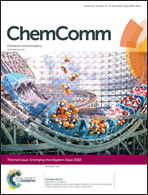Homologation chemistry with nucleophilic α-substituted organometallic reagents: chemocontrol, new concepts and (solved) challenges
Abstract
The transfer of a reactive nucleophilic CH2X unit into a preformed bond enables the introduction of a fragment featuring the exact and desired degree of functionalization through a single synthetic operation. The instability of metallated α-organometallic species often poses serious questions regarding the practicability of using this conceptually intuitive and simple approach for forming C–C or C–heteroatom bonds. A deep understanding of processes regulating the formation of these nucleophiles is a precious source of inspiration not only for successfully applying theoretically feasible transformations (i.e. determining how to employ a given reagent), but also for designing new reactions which ultimately lead to the introduction of molecular complexity via short experimental sequences.

- This article is part of the themed collection: 2018 Emerging Investigators


 Please wait while we load your content...
Please wait while we load your content...